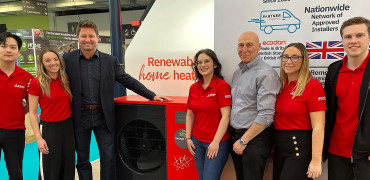At 15 years of age my school arranged for me to visit the local careers officer to discuss what career path I might want to take.
The careers officer wasn’t particularly helpful. When I told him I wanted to be an architect he shot me down because he knew I wasn’t particularly good at maths and knew I wouldn’t be taking maths at A-level.
“If you aren't willing to do A-Level maths, then you can forget being an architect.” He advised me that I should consider being a graphic designer instead.
Without realising it, he actually did me a favour.
He made me so angry I went straight home, opened the yellow pages, and began handwriting letters to every single architect in Sunderland, Newcastle and Washington Tyne & Wear asking them all if I could have a job as an apprentice to avoid doing full time A levels.
In construction you learn more in the real world than you do working in a classroom
Learning on the job
In the summer of 1990, just a few days after finishing my GCSE’s (I got a C in Maths BTW!) a wonderful architect in my hometown, David Johnson, gave me a job as his only apprentice at his small practice just 20 minute’s walk away from my Mam’s house.
What a commitment it was by him to invest in mine and the industry’s future.
David paid for me to go to college 1 day per week doing a B-TECT in Building Construction and then paid me to work in his office the remaining 4 days a week.
That apprenticeship completely changed my life. It was the best 2 years ever. I cannot begin to tell you how much I learned from David and being a part of his office.
That ‘real world’ experience doing real projects, doing site surveys, planning applications, building control applications, client’s meetings, site inspections, working with contractors, seeing every part of a building project from inception to completing changed my life.
I was a sponge soaking up every bit of knowledge about architecture and construction and I was flying! I don’t care what anyone says. In the construction business you learn way more working in the real world, in an office or on site, than you do working in a classroom.
Of course, a bit of classroom time to compliment your ‘real world’ work life is fantastic and I was lucky to have that had that in Wearside.
I will always be grateful to David Johnson for the opportunity, support and knowledge he gave me. There was no way I’d be where I am today without David giving me that apprenticeship. It was the foundation stone for the rest of my life.
What a waste!
So, you can probably work out that I am a MASSIVE FAN of apprenticeships and we now need more than ever!
The statistics tell the story.
According to the CITB Construction Outlook 2024 the construction industry needs 50,300 new workers EACH YEAR to meet the projected demand by 2028 and apprenticeship numbers in construction are staggeringly low.
33,000 people started construction apprenticeships in 2023/24, but according to the CITB apprenticeship rates would need to increase two or three times to fulfil recruitment needs.
One of the most frightening statistics I was made aware of at UK Construction Week 2025 from a leading industry figure is that only around half of all the people that begin an apprenticeship actually go on to complete their training!
There seems to be a number of reasons for this. These include insufficient support from tutors and employers contributing to apprentices leaving their programs early as well as low pay being a struggle during a cost of living crisis.
Other factors include poor course organisation, high workload, poor teaching quality and the challenges of balancing work and study.
ONLY 47% COMPLETE THEIR APPRENTICESHIPS. That’s is a terrible, terrible drop out rate. What a waste of potential talent!
An aging workforce
With the government setting a target of 600,000 heat pump installation PER YEAR, EVERY YEAR, the air source heat pump industry is desperate for more heat pump installers.
We need more gas engineers to make the transition to ASHPs and we need more apprentices to come into the industry.
Again, the numbers tell a powerful story.
It is worth noting that the average age of a UK plumber/gas engineer right now is over 50 years old and 50% of gas engineers are over 55. I’m not sure how many of them are looking to retrain as air source heat pump installers.
More worrying is the fact that only 60% of Gas Safe’s register is made up of qualified engineers under the age of 35!
With a workforce on the brink of retirement we need more young blood.
We currently have around 10,000-15,000 active heat pump installers in the UK. This is a relatively small number, but thankfully it is growing.
According to HeatPumps.org.uk to meet government targets we need 41,000 full-time installers by 2028 and 122,000 by the mid-2030s.
Interest in training is definitely growing, but clearly not at a fast enough rate.
More confidence needed
But training is only half the story. We need more demand and more confidence in the Air Source Heat Pump market.
Heat pumps still only make a small percentage of the UK heating market.
Many engineers still don’t see a clear future in heat pumps yet. They are cautious about leaving behind reliable gas and oil boiler work.
With less than 100,000 air source hat pump installations this year compared to 1.5 million gas boiler installations you can understand their concerns.
Without clear demand, newly trained engineers could be sitting on the sidelines.
Yes, the government has taken positive steps when it comes to training.
There is the £5m Heat Training Grant, the £8m Warm Home Skills programme and the £600m Constructions Skills package for new colleges, fast track apprenticeships and £2,000 Employer incentives, but there is no point in all of this training if there isn’t the increased demand for more Air Source Heat Pumps.
A ban on gas for new build
If the government is serious about Air Source Heat Pumps being a part for our journey to Net Zero Carbon Home Heating, then it needs to ban gas boilers in all new build home as quickly as possible.
Without this move, gas engineers will not make the transition to becoming air source heat pump installers and they won’t even think about taking on apprentices and investing in the young blood the industry so desperately needs.
We've got the ambition. We’ve got the technology. Now we need demand for a long-term sustainable future and then the young apprentices will come.
If there is the work, there is confidence and employers will commit the time and money to train the young people and will give them all of the help and support they need to complete their courses.
Real jobs for real people
Apprenticeships aren’t a backup plan, they’re the foundation of everything we want to achieve in housing, design, and sustainability.
If we’re serious about building greener homes and tackling climate change, then we need to get serious about skills. That means investing in training, championing the trades, and showing young people that these careers matter, because they absolutely do.
But it also means making sure that training leads somewhere, into real jobs, on real projects, with long-term support.
We need to get serious about changing policy and our antiquated building regulations to make our homes more sustainable, more comfortable and a lot cheaper to run.
We must end the burning of gas and adopt a cleaner, greener form of home heating. If we want to accelerate the ASHP industry then we must change the building regulations now!
The future of heating isn’t just about heat pumps themselves. It’s about the apprentices who will fit them, fix them, and lead us into a lower-carbon world.
Let’s back them, just as David Johnson backed me as a young 16-year-old and create the demand the industry needs!
George Clarke is a TV presenter, architect, writer and Ecodan Ambassador




